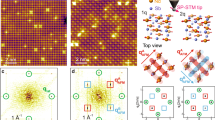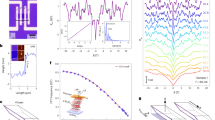Abstract
Understanding and control of spin degrees of freedom on the surfaces of topological materials are key to future applications as well as for realizing novel physics such as the axion electrodynamics associated with time-reversal (TR) symmetry breaking on the surface. We experimentally demonstrate magnetically induced spin reorientation phenomena simultaneous with a Dirac-metal to gapped-insulator transition on the surfaces of manganese-doped Bi2Se3 thin films. The resulting electronic groundstate exhibits unique hedgehog-like spin textures at low energies, which directly demonstrate the mechanics of TR symmetry breaking on the surface. We further show that an insulating gap induced by quantum tunnelling between surfaces exhibits spin texture modulation at low energies but respects TR invariance. These spin phenomena and the control of their Fermi surface geometrical phase first demonstrated in our experiments pave the way for the future realization of many predicted exotic magnetic phenomena of topological origin.
This is a preview of subscription content, access via your institution
Access options
Subscribe to this journal
Receive 12 print issues and online access
$209.00 per year
only $17.42 per issue
Buy this article
- Purchase on Springer Link
- Instant access to full article PDF
Prices may be subject to local taxes which are calculated during checkout





Similar content being viewed by others
References
Hasan, M. Z. & Kane, C. L. Topological insulators. Rev. Mod. Phys. 82, 3045–3067 (2010).
Moore, J. E. The birth of topological insulators. Nature 464, 194–198 (2010).
Fu, L. & Kane, C. L. Topological insulators with inversion symmetry. Phys. Rev. B 76, 045302 (2007).
Hsieh, D. et al. A topological Dirac insulator in a quantum spin Hall phase. Nature 452, 970–974 (2008).
Qi, X-L., Hughes, T. L. & Zhang, S-C. Topological field theory of TR invariant insulators. Phys. Rev. B 78, 195424 (2008).
Hor, Y. S. et al. Development of ferromagnetism in the doped topological insulator Bi2−xMnxTe3 . Phys. Rev. B 81, 195203 (2010).
Ji, H. W. et al. Bulk intergrowth of a topological insulator with a room-temperature ferromagnet Bi2−xFexSe3 . Phys. Rev. B 85, 165313 (2012).
Salman, Z. et al. The nature of magnetic ordering in magnetically doped topological insulator Bi2−xFexSe3. Preprint at http://arxiv.org/abs/1203.4850 (2012).
Essin, A. M., Moore, J. E. & Vanderbilt, D. Magnetoelectric polarizability and axion electrodynamics in crystalline insulators. Phys. Rev. Lett. 102, 146805 (2009).
Garate, I. & Franz, M. Inverse spin-galvanic effect in the interface between a topological insulator and a ferromagnet. Phys. Rev. Lett. 104, 146802 (2010).
Li, R., Wang, J., Qi, X-L. & Zhang, S-C. Dynamical axion field in topological magnetic insulators. Nature Phys. 6, 284–288 (2010).
Yu, R. et al. Quantized anomalous Hall effect in magnetic topological insulators. Science 329, 61–64 (2010).
Liu, M. et al. Crossover between weak localization and weak antilocalization in magnetically doped topological insulator. Phys. Rev. Lett. 108, 036805 (2012).
Vobornik, I. et al. Magnetic proximity effect as a pathway to spintronic applications of topological insulators. Nano Lett. 11, 4079–4082 (2011).
Chen, Y-L. et al. Massive Dirac fermion on the surface of a magnetically doped topological insulator. Science 329, 659–662 (2010).
Wray, L. A. et al. A topological insulator surface under strong Coulomb, magnetic and disorder perturbations. Nature Phys. 7, 32–37 (2011).
Zhang, Y. et al. Crossover of the three-dimensional topological insulator Bi2Se3 to the two-dimensional limit. Nature Phys. 6, 584–588 (2010).
Beidenkopf, H. et al. Spatial fluctuations of helical Dirac fermions on the surface of topological insulators. Nature Phys. 7, 939–943 (2011).
Eremeev, S. V. et al. The origin of 2DEG states at the surface of layered topological insulators. Preprint at http://arxiv.org/abs/1107.3208 (2011).
Xu, S-Y. et al. Dirac point spectral weight suppression, surface ‘gaps’, and ‘twin-peak’ intensity profiles in nonmagnetic and magnetic topological insulators. Preprint at http://arxiv.org/abs/1206.0278 (2012).
Sato, T. et al. Unexpected mass acquisition of Dirac fermions at the quantum phase transition of a topological insulator. Nature Phys. 7, 840–844 (2011).
King, P. D. C. et al. Large tunable Rashba spin splitting of a two-dimensional electron gas in Bi2Se3 . Phys. Rev. Lett. 107, 096802 (2011).
Nakajima, R. et al. Electron-yield saturation effects in L-edge x-ray magnetic circular dichroism spectra of Fe, Co, and Ni. Phys. Rev. B 59, 6421–6429 (1999).
Edmonds, K. W. et al. Ferromagnetic moment and antiferromagnetic coupling in (Ga, Mn)As thin films. Phys. Rev. B 71, 064418 (2005).
Xia, Y. et al. Observation of a large-gap topological-insulator class with a single Dirac cone on the surface. Nature Phys. 5, 398–402 (2009).
Hsieh, D. et al. A tunable topological insulator in the spin helical Dirac transport regime. Nature 460, 1101–1105 (2009).
Fu, L. Hexagonal warping effects in the surface states of the topological insulator Bi2Te3 . Phys. Rev. Lett. 103, 266801 (2009).
Xu, S-Y. et al. Topological phase transition and texture inversion in a tunable topological insulator. Science 332, 560–564 (2011).
Lu, H-Z., Shi, J. R. & Shen, S-Q. Competition between weak localization and antilocalization in topological surface states. Phys. Rev. Lett. 107, 076801 (2011).
Cho, G. Y. Possible topological phases of bulk magnetically doped Bi2Se3: turning a topological band insulator into the Weyl semimetal. Preprint at http://arxiv.org/abs/1110.1939 (2011).
Halász, G. B. & Balents, L. Time reversal invariant realization of the Weyl semimetal phase. Phys. Rev. B 85, 035103 (2011).
Zhang, D. et al. Interplay between bulk ferromagnetism, surface states, and quantum corrections in a magnetically doped topological insulator. Preprint at http://arxiv.org/abs/1206.2908 (2012).
Acknowledgements
Work at Princeton University is supported by the US National Science Foundation Grant, NSF-DMR-1006492. M.Z.H. acknowledges visiting-scientist support from Lawrence Berkeley National Laboratory and additional partial support from the A. P. Sloan Foundation and NSF-DMR-0819860. The spin-resolved and spin-integrated photoemission measurements using synchrotron X-ray facilities are supported by the Swedish Research Council, the Knut and Alice Wallenberg Foundation, the Swiss Light Source, the Swiss National Science Foundation, the German Federal Ministry of Education and Research, and the Basic Energy Sciences of the US Department of Energy. Theoretical computations are supported by the US Department of Energy (DE-FG02-07ER46352 and AC03-76SF00098) as well as the National Science Council and Academia Sinica in Taiwan, and benefited from the allocation of supercomputer time at NERSC and Northeastern University’s Advanced Scientific Computation Center. Sample growth and characterization are supported by US DARPA (N66001-11-1-4110). We gratefully acknowledge A. Preobrajenski for beamline assistance on XMCD measurements (supported by DE-FG02-05ER46200) at the D1011 beamline at Maxlab in Lund, Sweden. We acknowledge helpful discussions with S-Q. Shen and L. Balents. We also thank S-K. Mo and A. Fedorov for beamline assistance on spin-integrated photoemission measurements (supported by DE-FG02-05ER46200) at Lawrence Berkeley National Laboratory (The synchrotron facility is supported by the US DOE).
Author information
Authors and Affiliations
Contributions
S-Y.X. performed the experiments with assistance from M.N., C.L., L.A.W., N.A. and M.Z.H.; D.Z., A.R. and N.S. provided samples; M.L., T.B., J.S-B., O.R., G.L., B.S., J.H.D. and J.O. provided beamline assistance; T-R.C., H-T.J., H.L. and A.B. carried out the theoretical calculations; M.Z.H. was responsible for the overall direction, planning and integration among the different research units.
Corresponding author
Ethics declarations
Competing interests
The authors declare no competing financial interests.
Supplementary information
Supplementary Information
Supplementary Information (PDF 5584 kb)
Rights and permissions
About this article
Cite this article
Xu, SY., Neupane, M., Liu, C. et al. Hedgehog spin texture and Berry’s phase tuning in a magnetic topological insulator. Nature Phys 8, 616–622 (2012). https://doi.org/10.1038/nphys2351
Received:
Accepted:
Published:
Issue Date:
DOI: https://doi.org/10.1038/nphys2351
This article is cited by
-
Surface coupling in Bi2Se3 ultrathin films by screened Coulomb interaction
Nature Communications (2023)
-
Energy gap of topological surface states in proximity to a magnetic insulator
Communications Physics (2023)
-
Proximity-induced magnetic order in topological insulator on ferromagnetic semiconductor
Science China Information Sciences (2023)
-
Realization of unpinned two-dimensional dirac states in antimony atomic layers
Nature Communications (2022)
-
Robust behavior and spin-texture stability of the topological surface state in Bi2Se3 upon deposition of gold
npj Quantum Materials (2022)



